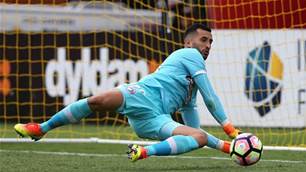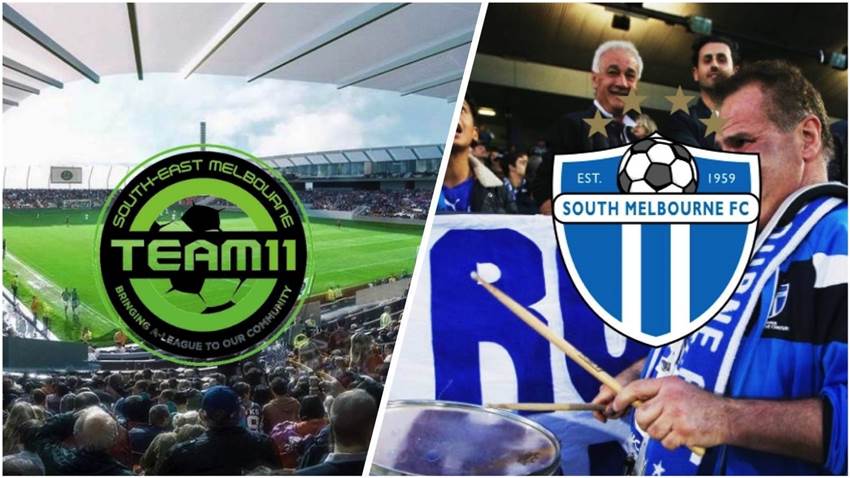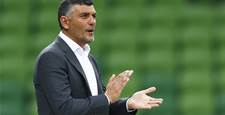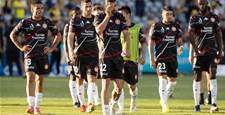Can what unites us also divide us? Prominent expansion bids Team 11 and South Melbourne couldn’t be more different, and yet also, more alike.
“I virtually grew up at the club, spending many days and nights there. We would train on the outside grounds next to Middle Park Stadium and some afternoons after training coincided with the seniors, I used to stop and just watch in awe as they walked off the pitch. To me, they were gods. I watched them play every Sunday home and away.
“They inspired me to work harder, run harder, tackle harder, try tricks, mixing ambition with ability in the hope that they would see me and notice me. An excitement rushed through my blood. A club should be more than just a club, more than just football. It’s a deeper meaning for everyone that’s part of it.”
- Michael Valkanis
Despite both A-League bids emerging from the same state and passionate fervour for football, it’s nigh impossible to compare South Melbourne and Team 11 like for like. One is are a club with 59 years of rich history, the other doesn't really exist yet.
But there’s a lot more to the Dandenong club, and this discussion, than meets the eye. Not least the over saturation of the Melbourne sporting market, not most the – at times – divisive effect of South’s fervent fan base.
What brings these two bids closer together than almost any other is a desire that borders on necessity. Both bid spokesmen elicit a passion that borders on desperation; not for themselves, or even their clubs, but their communities.
South have been both dynamic and polarising throughout the extended campaign leading up to today's FFA decision, but bid spokesman Bill Papastergiadis remains supremely confident in his side’s suitability.
When he gets the opportunity to espouse his club’s values, he does so with the reverence of a preacher.
“We think we have a world class boutique stadium,” he begins. “We recently built a $3 million social club and a futsal centre to create 24 hour experience at a football game. We have 30 accredited coaches, 90,000 social media followers, a million views of our YouTube channel.
“We set most of the attendance records in the NSL and some of them are still standing. When we played Sydney FC in the FFA Cup, we out-rated 70% of the A-League games that season.
“We believe we’re the most successful club in Australian history. We’re a men and women’s club. We were awarded the Oceania Club of the Century. We do a fatality Friday fundraiser for the police, walking soccer for pensioners, we’ve been recognised by the FFV for blind and female football leagues.
“52 Socceroos, a former national head coach in Ange Postecoglou. A number of A-League coaches. Hundreds of professional footballers. We developed the Australia-China football federation, headed by senior members of the largest ethnic group in Victoria.

“We’ve trained 80 teams in China, we’re linked with Real Madrid and we won virtually every junior competition in Victoria last season…”
He continues, but the point is clear. There’s a reason why South fans are so ardent that their team deserves a shot in the A-League; it’s impossible to argue in a perfect competition that such a prepared, passionate and important part of Australian football should be left out.
The problem FFA faces as it seeks “sustainable” expansion, is who needs it more. Who can provide the feel good story Australian football so desperately requires?
Unlike South Melbourne, which Papastergiadis says is the “most accessible club in Melbourne”, it takes almost two hours on a train and a bus to get from AAMI Park to central Dandenong on a Friday night.
While you stare out the window as you slump along the Pakenham line, you almost feel as if you’re travelling through the 160 nations the region represented in its last census. The diehards who make this pilgrimage after watching one of two Victorian A-League clubs herald from the most multicultural community, in one of the most ethnically diverse countries on earth.
As project officer for the Team 11 A-League bid, Matt Windley, remarks hopefully, “90% of people in this area come from countries where football’s the number one sport.”
But now the region that describes itself as 'The City of Opportunity' – a city that offers a home to more refugees than any other in Victoria – is asking for a chance itself.
“I’ve got a young family and building a better community for them is something that’s really important to me, and that rings true for many families,” Windley says from his Berwick home. He’s taken the morning off for “dad-duties”.
“The social benefits to an A-League club are numerous here. It’s hard for people to integrate into a new society, but giving them an outlet to rally behind can make a massive social impact and give better role models to our boys and girls.”
Football Federation Australia’s expansion criteria for two new A-League teams didn’t prioritise the community impact of hosting a football club, but with a new era of governance beginning, Team 11 are keen on highlighting the positive effect they could have in an area where almost 65% of residents are born overseas.
The Greater Dandenong region has one of the highest-crime rates in Victoria, its median income is just over half the national average and its unemployment rate is over double.
These issues have a significant effect on the region’s families, with seven incidents of domestic violence reported in Greater Dandenong each day, and one in six single-parent households reporting in 2009 that they had ran out of food and been unable to afford more in the past year.
Branded the ‘home of the Apex gang’, in 2016 news.com.au called Greater Dandenong “the worst part of Melbourne”. Former Mayor and local councillor Jim Memeti says he is “well aware” the region has copped a lot of bad publicity.
But the Team 11 backer believes the A-League has the opportunity to not only attract a hotbed of football fans in Dandenong, but through hopes for a 20,000 seater stadium, turn the region’s fortunes around.
“Everyone knows we’re a low socio-economic area,” Memeti says. “But a new stadium will generate more hotels, more cafes and more restaurants.
“Dandenong is the heart of Victoria’s industry and we have massive local companies that are interested in sponsoring the club.
“The economic benefits to choosing Team 11 are huge and I’ve already been approached by many people looking to build hotels if the stadium gets built.”
If a group of passionate local councillors and a former Herald Sun journalist teaming up to form an A-League super-club sounds like a shonky TV plotline, it’s because in some ways it is. The bid started with no name, stadium, business or football experience, just an ambitious plan to bring the world game to cosmopolitan south-east Victoria.
But what began as a pipedream has quickly become a frontrunner among the six remaining bids for two A-League licences, garnering broad support for what the public dares to dream could be another Western Sydney Wanderers.

Windley’s the first to admit that it’s “quite a bizarre” situation, as he says: “Councils are definitely not in the business of running and creating professional sporting clubs.”
But surprisingly, none of this appears to faze the journalist who gave up a career at Australia’s biggest newspaper to grasp the optimistic role.
Perhaps it’s that with FFA governance in turmoil and great uncertainty surrounding the sport’s future, Team 11’s unlikely journey doesn’t seem that strange for Australian football.
“Hopefully other business, football-minded people see the common sense in it, then when the councillors hand over the keys, the right people are in it for the right reasons,” Windley says.
“Even though the majority of Victoria’s population live in the south east or the west, we all have to come to the city to watch our sport.”
Windley isn’t just talking as a spokesman; his daughter is a Melbourne Victory member and he regularly makes this trip himself.
“A lot of people find it so hard to get to games nowadays, especially late matches when you’ve got kids,” he continues. “I live a good 45km out of the city and it took me an hour and a half to get to one of the last games.
“If I parked my car at Narre Warren station, I’d be at Team 11’s prospective ground in 10 minutes. Why can’t we stay in our own backyard?
“Football has a massive opportunity to make a difference in this part of Victoria and claim this region like it’s never been claimed before. Only this sport and this league can do that right now.”
Windley’s enthusiasm is infectious. He cares about the future of his community and the cost of petrol for parents taking their kids to football practice.
In many ways Team 11’s bid is propelled by emotion and community – there are continuing question marks over its lack of stadium funding and its financial capability to run an A-League, W-League and Youth League side.
Even if the state government secures $170 million in funding, Dandenong Stadium is likely to take at least two seasons to build.
This leaves the club playing at Casey Fields, a 350 seater VFL oval, for its crucial formation period. Meanwhile, their major Victorian rivals, South Melbourne, have a ready-to-go 7,400 seater stadium, thousands of pre-existing fans and half-a-century of history.
“We have a clear financial advantage over every other expansion candidate,” Papastergiadis says. “We are a ready-made club, we’re not a club that says we’re aiming to do this. We can do it now.”
In a sporting market that’s more sopping than saturated, there’s little room for both. Melbourne City have already struggled to create a consistent atmosphere at AAMI Park. It’s a mantra that’s been echoed by A-League chief Greg O’Rourke, who all but ruled out the possibility of both Victorian sides gaining entrance in this expansion period to the Sydney Morning Herald.
“There's geographies of Australia that are not connected yet to the A-League and the teams that we would propose to put forward would enable that connection of that geography,” he added.
But how can anyone decide which Australian football needs more right now?
Windley won’t let that get him down. Team 11 was never just a career opportunity – it’s a chance at a better life.
“There are communities out here that don’t even know the A-League exists, yet they’re passionate football supporters,” Windley says. “They’d get behind something that’s local to them in a heartbeat.
“I’m yet to have a negative conversation with a local club or community group. Every local club needs to feel like they’re part of us from the start and as soon as I get 10 minutes with someone, they’re sold.
“I’m a glass half-full kind of person, I think people will be able to cop two years of playing at Casey Fields,” he insists. “If we get the numbers right I believe we can be a super club in the A-League. I really do.”
South Melbourne bid spokesman, Bill Papastergiadis, is a little more doubtful.
“Let’s be frank, to build a 20,000 seater stadium will cost between $350-400 million,” he says. “That’s a significant cost for 10-12 home games. The business case for that will really need to be understood because it also takes decades to build that level of passion and support.
“Dandenong isn’t preferable at this stage of the A-League, every sporting club that has moved games to the Dandenong area, like St. Kilda in the AFL, have quickly retreated.
“They’ve found that their members, supporters and players aren’t interested in moving there. Proximity to infrastructure and other forms of entertainment and services are key drivers.
“We’re going to be aiming for 8-10,000 people per match. We were averaging 8,000 per game in 2001 so we think that’s well within our gap.

“There’s a huge debate over what do you need to have a successful ambience and we’ve seen that A-League matches played in empty stadium kills viewer interest.
“Tight, packed stadiums is the successful model. We watched Leganes and Real Madrid play in a 13,000 stadium when we toured Spain and my motto is if it’s good enough for La Liga, it’s good enough for Australian football.”
While South Melbourne only require a fraction of their stadium’s capacity to break even, forming Team 11 was a significant risk for three councils (Casey, Greater Dandenong and Cardinia Shire) with substantial economic challenges.
They’ve already spent hundreds of thousands of ratepayer dollars on setting up the bid with no surety of success.
And with many existing A-League clubs unable to turn a profit, despite Team 11 securing private investors, the council’s outpouring might not end there.
“The councils have made contact with 100 different grassroots football clubs that are going to form our supporter base,” Memeti says. “Hopefully our kids will be able to dream about playing for this team – we’re trying to give our community an aspiration.
“A-League clubs usually lose between $1-2 million a year, but we think we’re able to cover those losses through sponsorships.
“Dandenong is where the future is. It’s the heartland of football and there are no sports like it here, we’ll be another Western Sydney Wanderers. Where’s South Melbourne’s growth going to come from?”
While South can lay claim to one of the most established youth programs across Australia, the argument remains that the effect an A-League club could have on the Dandenong region centres largely on its youth.
It may be FFA's responsibility to choose between a bid that delivers the development of future Socceroos, or one that promises the development of proud, engaged Australians.

White Star Dandenong Soccer Club is one of the largest in the region with over 180 registered footballers, the majority in youth teams, and club president Robert Drodsz has seen football’s “tangible” social benefits first hand.
“Football is one of the ways we can bring different cultures and nationalities together, and keep our kids occupied and off the streets,” Drozdz says.
“It allows kids to learn from an early age about different cultures through speaking to each other and playing together, and the sense of community it brings creates awareness and acceptance from the parents as well.
“The grassroots support here is huge. If you drive around on a weekend you see kids playing football all the time, it brings everyone together and keeps them active.
“Team 11 have built this bid around engaging with clubs at a local level. It’s got the whole community behind it and we all feel like we have an active stake in its success. I haven’t seen this sort of community engagement from other bids.”
While the A-League’s stagnation creates the desire for fresh-faces, there’s more than just footballing potential in the Dandenong region.
“We’re a multicultural club – if you look at our player development and coaches, we’re from 80 different ethnicities. If you look at the board composition, we’re the only club that has a senior government minister on its board in addition to the former federal sports minister. I think we reflect the society we live in.”
Ultimately there is no wrong or right answer, just 50 shades of blue and green. In the battle for Australia’s hearts and minds, there is no winner. In the fragmented climate that Australian football has created, to the victor goes the spoiled.
But that won’t be any consolation to two of the most passionate stakeholders in Australian football.
“If South Melbourne are chosen it means that aspirational football is back,” Papastergiadis says. “We’re the custodians for these people. I’m involved to give kids the ability to follow their dreams.”
“Imagine opening night at Dandenong Stadium,” Windley muses, his voice softening for a moment.
“To have Sudanese people sitting side-by-side with Croatian, Serbian, Albanian, Greek, Vietnamese, Chinese, Kiwis, British, Scottish – that is so cool. That is the world game. That is Australia.”
Related Articles
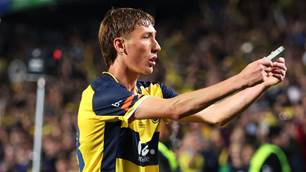
Socceroo-in-waiting seals Championship deal

Fringe Socceroo swerves A-League to remain in Europe after Fulham exit
